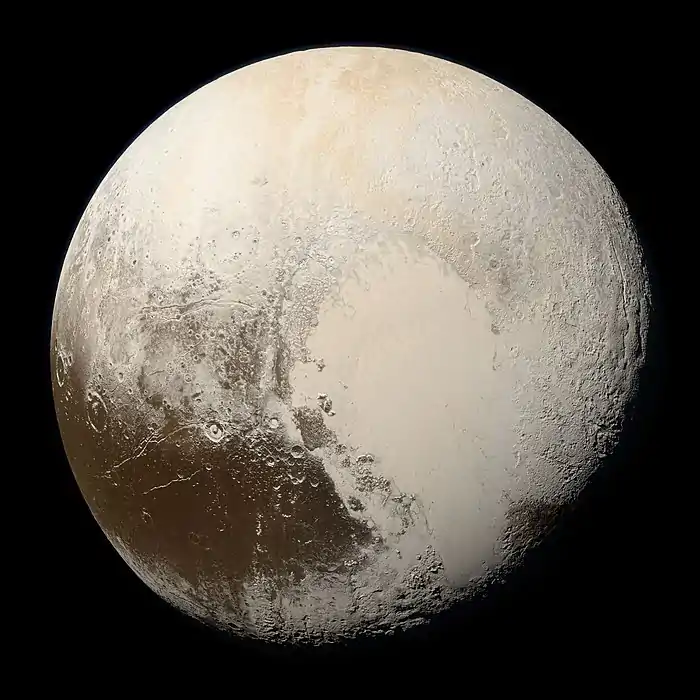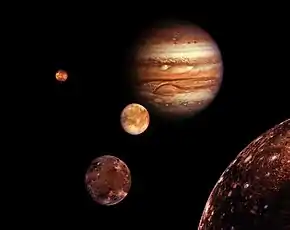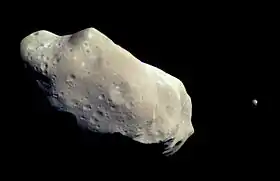120347 Salacia
120347 Salacia, provisional designation 2004 SB60, is a trans-Neptunian object in the Kuiper belt, approximately 850 kilometers in diameter. As of 2018, it is located about 44.8 astronomical units from the Sun, and reaches apparent magnitude 20.7 at opposition.
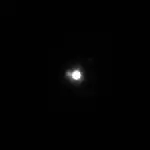 Salacia and its moon Actaea, imaged by the Hubble Space Telescope on 21 July 2006. | |
| Discovery [1][2] | |
|---|---|
| Discovered by | H. G. Roe M. E. Brown K. M. Barkume |
| Discovery site | Palomar Obs. |
| Discovery date | 22 September 2004 |
| Designations | |
| (120347) Salacia | |
| Pronunciation | /sæˈleɪʃ(i)ə/ (sa-LAY-sh(i)ə) |
Named after | Salacia (Roman mythology)[2] |
| 2004 SB60 | |
| TNO [1] · Cubewano [3] Extended [4] | |
| Adjectives | Salacian |
| Orbital characteristics [1] | |
| Epoch 31 May 2020 (JD 2459000.5) | |
| Uncertainty parameter 3 | |
| Observation arc | 37.16 yr (13,572 days) |
| Earliest precovery date | 25 July 1982 |
| Aphelion | 46.670 AU |
| Perihelion | 37.697 AU |
| 42.184 AU | |
| Eccentricity | 0.10636 |
| 273.98 yr (100,073 days) | |
| 123.138° | |
| 0° 0m 12.951s / day | |
| Inclination | 23.921° |
| 279.880° | |
| 312.294° | |
| Known satellites | 1 (Actaea) |
| Physical characteristics | |
Mean diameter | 846±21 km[5][lower-alpha 1] 854±45 km (equal albedos)[6] 866±37 km[7] |
| Mass | (4.922±0.071)×1020 kg (system)[5] (4.38±0.16)×1020 kg (system mass)[6][8] |
Mean density | 1.5±0.12 g/cm3[5] 1.29+0.29 −0.23 g/cm3 (system)[6] 1.26±0.16 g/cm3[7] |
| 6.09 h (0.254 d) | |
Sidereal rotation period | 6.09 h[1] |
| 0.044±0.004[6] 0.042±0.004[7] | |
| V−I = 0.87±0.01[8] | |
| 20.7 | |
| 4.360±0.011 (system)[8] 4.476±0.013 (Salacia)[8] 6.850±0.053 (Actaea)[8] 3.9[1] | |
Salacia was discovered on 22 September 2004, by American astronomers Henry Roe, Michael Brown and Kristina Barkume at the Palomar Observatory in California, United States. It has been observed 124 times, with precovery images back to 25 July 1982.[2] Salacia orbits the Sun at an average distance that is slightly greater than that of Pluto. It was named after the Roman goddess Salacia and has a single known moon, Actaea.
Brown estimated that Salacia is very likely a dwarf planet.[9] However, William Grundy et al. argue that objects such as Salacia, in the size range of 400–1000 km, with albedos less than ≈0.2 and densities of ≈1.2 g/cm3 or less, have likely never compressed into fully solid bodies, let alone differentiated or collapsed into hydrostatic equilibrium, and so are highly unlikely to be dwarf planets.[10]
Orbit

Salacia is a non-resonant object with a moderate eccentricity (0.11) and large inclination (23.9°), making it a scattered–extended object in the classification of the Deep Ecliptic Survey and a hot classical in the classification system of Gladman et al.,[11] which may be a non-distinction if they are part of a single population that formed during the outward migration of Neptune.[8] Salacia's orbit is within the parameter space of the Haumea collisional family, but Salacia is not part of it, because it lacks the strong water-ice absorption bands typical of its members.[8]
Physical characteristics
As of 2019, the total mass of the Salacia–Actaea system is estimated at (4.922±0.071)×1020 kg, with an average system density of 1.51 g/cm3; Salacia itself is estimated to be around 846 km in diameter.[5] Salacia has the lowest albedo of any known large trans-Neptunian object.[8] According to the estimate from 2017 based on an improved thermophysical modelling the size of Salacia is slightly different at 866 km and its density is therefore lower being 1.26 g/cm3 (based on old mass).[7]
Salacia was previously believed to have a mass of around (4.38±0.16)×1020 kg, in which case it would also have had the lowest density (around 1.29 g/cm3) of any known large TNO;[6] William Grundy and colleagues proposed that this low density would imply that Salacia never collapsed into a solid body, in which case it would not be in hydrostatic equilibrium.[10] Salacia's infrared spectrum is almost featureless, indicating an abundance of water ice of less than 5% on the surface.[6][12] Its light-curve amplitude is only 3%.[8]
Mike Brown's website lists Salacia as nearly certainly a dwarf planet,[9] but the IAU has not formally recognized it as such.[13][14]
Satellite
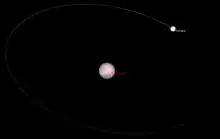
Salacia has one natural satellite, Actaea, that orbits its primary every 5.49380±0.00016 d at a distance of 5619±89 km and with an eccentricity of 0.0084±0.0076. It was discovered on 21 July 2006 by Keith Noll, Harold Levison, Denise Stephens and William Grundy with the Hubble Space Telescope.[15]
Actaea is 2.372±0.060 magnitudes fainter than Salacia,[6] implying a diameter ratio of 2.98 for equal albedos.[8] Hence, assuming equal albedos, it has a diameter of 286±24 km[6] According to the estimate from 2017 based on an improved modelling the size of Actaea is slightly larger being 290±21 km.[7]
Actaea has the same color as Salacia (V−I = 0.89±0.02 and 0.87±0.01, respectively), supporting the assumption of equal albedos.[8]
It has been calculated that the Salacia system should have undergone enough tidal evolution to circularize their orbits, which is consistent with the low measured eccentricity, but that the primary need not have been tidally locked.[8] The ratio of its semi-major axis to its primary's Hill radius is 0.0023, the tightest trans-Neptunian binary with a known orbit.[8] Salacia and Actaea will next occult each other in 2067.[8]
Name
This minor planet was named after Salacia (/sæˈleɪʃə/), the goddess of salt water and the wife of Neptune.[2] Naming citation was published on 18 February 2011 (M.P.C. 73984).[16]
The moon's name, Actaea /ækˈtiːə/, was assigned on the same date. Actaea is a nereid or sea nymph.
See also
Notes
- approximation if Salacia and Actaea were both spherical and had the same albedo
References
- "JPL Small-Body Database Browser: 120347 Salacia (2004 SB60)" (2019-09-21 last obs.). Jet Propulsion Laboratory. 7 November 2019. Retrieved 20 February 2020.
- "120347 Salacia (2004 SB60)". Minor Planet Center. Retrieved 22 July 2018.
- "MPEC 2009-R09 :Distant Minor Planets (2009 SEPT. 16.0 TT)". IAU Minor Planet Center. 2009-09-04. Retrieved 2011-07-05.
- Buie, Marc W. "Orbit Fit and Astrometric record for 120347" (2007-08-12 using 62 of 73 observations). SwRI (Space Science Department). Retrieved 2009-10-04.
- Grundy, W. M.; Noll, K. S.; Roe, H. G.; Buie, M. W.; Porter, S. B.; Parker, A. H.; Nesvorný, D.; Benecchi, S. D.; Stephens, D. C.; Trujillo, C. A. (2019). "Mutual Orbit Orientations of Transneptunian Binaries" (PDF). Icarus. 334: 62–78. doi:10.1016/j.icarus.2019.03.035. ISSN 0019-1035. Archived from the original (PDF) on 2020-01-15. Retrieved 2019-10-26.
- Fornasier, S.; Lellouch, E.; Müller, P., T.; et al. (2013). "TNOs are Cool: A survey of the trans-Neptunian region. VIII. Combined Herschel PACS and SPIRE observations of 9 bright targets at 70–500 µm". Astronomy & Astrophysics. 555: A92. arXiv:1305.0449v2. Bibcode:2013A&A...555A..15F. doi:10.1051/0004-6361/201321329.
- Brown, Michael E.; Butler, Bryan J. (20 June 2017). "The Density of Mid-sized Kuiper Belt Objects from ALMA Thermal Observations". The Astronomical Journal. 154 (1): 19. doi:10.3847/1538-3881/aa6346.
- Stansberry, J.A.; Grundy, W.M.; Mueller, M.; et al. (2012). "Physical Properties of Trans-Neptunian Binaries (120347) Salacia–Actaea and (42355) Typhon–Echidna". Icarus. 219 (2): 676–688. Bibcode:2012Icar..219..676S. CiteSeerX 10.1.1.398.6675. doi:10.1016/j.icarus.2012.03.029.
- Brown, Michael E. "How many dwarf planets are there in the outer solar system? (updates daily)". California Institute of Technology. Retrieved 2016-11-29.
- W.M. Grundy, K.S. Noll, M.W. Buie, S.D. Benecchi, D. Ragozzine & H.G. Roe, 'The Mutual Orbit, Mass, and Density of Transneptunian Binary Gǃkúnǁʼhòmdímà ((229762) 2007 UK126)', Icarus (forthcoming, available online 30 March 2019) Archived 7 April 2019 at the Wayback Machine DOI: 10.1016/j.icarus.2018.12.037,
- Gladman, B.; Marsden, B. G.; VanLaerhoven, C. (2008). "Nomenclature in the Outer Solar System" (PDF). The Solar System Beyond Neptune. p. 43.
- Schaller, E. L.; Brown, M. E. (2008). "Detection of Additional Members of the 2003 EL61 Collisional Family via Near-Infrared Spectroscopy". Astrophysical Journal. 684 (2): L107–L109. arXiv:0808.0185. Bibcode:2008ApJ...684L.107S. doi:10.1086/592232.
- "Planetary Names: Planet and Satellite Names and Discoverers". Gazetteer of Planetary Nomenclature. International Astronomical Union (Working Group for Planetary System Nomenclature). Retrieved 10 June 2012.
- "List of Dwarf Planets". NASA. Archived from the original on 2012-05-04. Retrieved 2012-06-09.
- "IAUC 8751: (120347) 2004 SB_60; 2006gi, 2006gj; V733 Cep". Cbat.eps.harvard.edu. Retrieved 2014-06-14.
- "MPC/MPO/MPS Archive". Minor Planet Center. Retrieved 3 April 2017.
External links
- (120347) Salacia at Johnston's Archive
- Salacia: As big as Ceres, but much farther away (Emily Lakdawalla – 2012/06/26)
- 120347 Salacia at the JPL Small-Body Database

_(cropped).jpg.webp)
